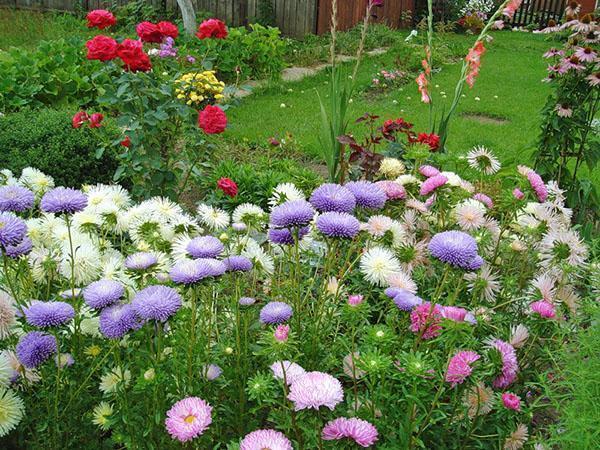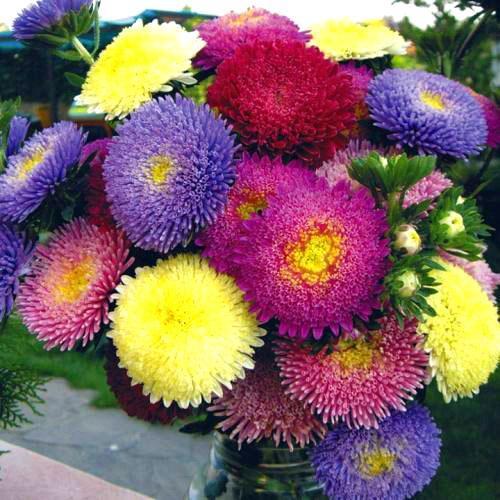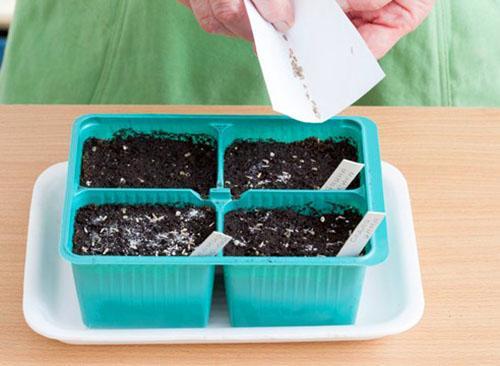The subtleties of growing an annual aster
 One of the most common types of annual flowers in dachas and personal plots is aster, planting and caring for it in the open field is not particularly difficult.
One of the most common types of annual flowers in dachas and personal plots is aster, planting and caring for it in the open field is not particularly difficult.
Currently, there are over 800 varieties of this crop. By the type of inflorescences, they can be divided into the following groups:
- simple or not terry;
- semi-double;
- terry;
- thick double.

- pyramidal;
- columnar;
- oval;
- spreading.
The varietal variety of this flower is impressive. So how and when to sow asters?
Sowing dates
 The timing of sowing asters largely depends on the growing conditions and climatic characteristics of the region. To get an earlier flowering, it is recommended to grow them through seedlings. Plants sown directly into the ground or before winter will bloom much later.
The timing of sowing asters largely depends on the growing conditions and climatic characteristics of the region. To get an earlier flowering, it is recommended to grow them through seedlings. Plants sown directly into the ground or before winter will bloom much later.
Aster seeds lose their germination very quickly. Therefore, when purchasing them, you must definitely pay attention to the expiration date and choose only the freshest seed material.
Novice growers very often ask: how many asters sprout? If the seeds are fresh and of high quality, and the conditions are favorable, then the emergence of seedlings takes only a few days. In cases of a significant drop in temperature when sowing in the ground or insufficient moisture, the emergence of seedlings can be delayed up to 7-10 days. It makes no sense to wait for the sprouts to appear after this time.
Growing seedlings
 Growing aster seedlings is not particularly difficult. With the seedling method, sowing is carried out in mid-March in a light and sufficiently nutritious soil. For example, you can use peat soil to grow seedlings of flowers and vegetables. The optimum temperature for germination of aster seeds is + 20 ° C.
Growing aster seedlings is not particularly difficult. With the seedling method, sowing is carried out in mid-March in a light and sufficiently nutritious soil. For example, you can use peat soil to grow seedlings of flowers and vegetables. The optimum temperature for germination of aster seeds is + 20 ° C.
 After emergence, it is reduced to 15-18 °. This prevents the seedlings from pulling out. Aster seedlings are not particularly demanding. It is enough to loosen and water young plants in time.
After emergence, it is reduced to 15-18 °. This prevents the seedlings from pulling out. Aster seedlings are not particularly demanding. It is enough to loosen and water young plants in time.
With dense sowing in the phase of 2-3 true leaves, you can pick them.
Planting seedlings in open ground
 Inexperienced growers very often ask: when to plant asters in open ground and are they afraid of recurrent frosts? They begin to disembark when warm, stable weather sets in. In most regions, this time falls in early May. In colder and rainy weather, these periods may shift by a week, or even two. In general, aster seedlings painlessly tolerate frosts down to -3 °, therefore, after planting, they do not need additional shelter.
Inexperienced growers very often ask: when to plant asters in open ground and are they afraid of recurrent frosts? They begin to disembark when warm, stable weather sets in. In most regions, this time falls in early May. In colder and rainy weather, these periods may shift by a week, or even two. In general, aster seedlings painlessly tolerate frosts down to -3 °, therefore, after planting, they do not need additional shelter.
To improve the survival rate of plants in the open field, they must be hardened for a week before planting.
So we learned how and when to plant asters, now it remains to figure out with the subsequent care.
Outdoor care
 Growing asters outdoors is not particularly difficult. Open, well-lit areas with well-drained soils are best suited for planting. Also, this culture grows and develops best when protected from cold northerly winds.
Growing asters outdoors is not particularly difficult. Open, well-lit areas with well-drained soils are best suited for planting. Also, this culture grows and develops best when protected from cold northerly winds.
Of the main measures for the care of one-year aster, it is worth noting timely weeding, loosening of the soil and watering... It is also worth knowing that when growing this crop, the plantings cannot be greatly thickened.This will lead to the emergence of various fungal diseases.
Planting and caring for aster in the open field is impossible without top dressing. Especially if the plants are grown for subsequent cutting into bouquets. The first time the plants are fed two weeks after planting the seedlings. To do this, use complex mineral fertilizers for flowers... The second feeding is carried out in the budding phase. For her, it is best to choose fertilizers with a high content of phosphorus and potassium. The third time the asters are fed after the beginning of flowering.
In no case should fresh manure or other organic matter be used to feed asters. Their use can contribute to the appearance of fungal diseases.
Abundant and prolonged flowering of asters is also facilitated by the regular removal of fading inflorescences. With their systematic pruning, the plants retain their decorative qualities until late autumn.
Planting an annual aster and its subsequent care in the open field does not require any special skills and is available to anyone. The main thing is to pay due attention to plants and take appropriate care. And then they will surely thank you with an abundance of large and bright inflorescences and a long flowering period.